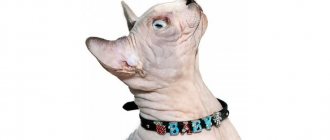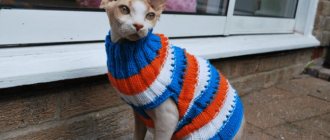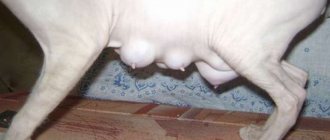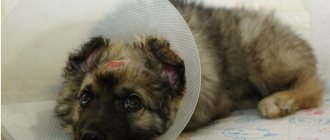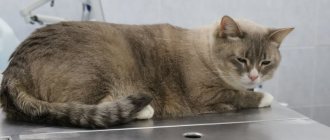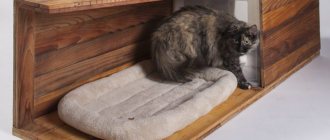Postoperative blanket: what is it and what is it for?
A blanket is a tight “cover” placed over the stomach of an operated cat.
It serves several purposes at once:
- Protects the postoperative wound from contamination by pathogenic and conditionally pathogenic microflora.
- The blanket prevents the animal from trying to scratch and lick its belly. This is a reflexive behavior of a cat trying to speed up the healing process. But in practice, constant licking of the wound leads to the exact opposite result.
- Also, a pressure bandage pulls the edges of the wound together, which promotes healing by primary intention. Simply put, regeneration in this place will go faster, and not so many reserves of the animal’s body will be spent on it.
- A properly applied and high-quality blanket does not allow the muscular wall of the abdominal wall to stretch too much and weaken. This prevents the belly from sagging in the future.
Instructions for putting on
Most often, the blanket is secured to the animal’s body using regular ties. Velcro versions are available for sale. Dressing a cat in such a bandage is much easier, but blankets with Velcro are more expensive.
The first putting on of the blanket occurs immediately after the operation. Most often at this time the animal is still under anesthesia or only partially conscious. In this state, the cat does not offer resistance, which greatly simplifies the process. You should be very careful and careful, do not make sudden movements when manipulating the animal’s body: fresh seams can be damaged very easily.
In the future, you will have to repeatedly treat the wounds and put a bandage on an already active animal.
It is important to act as calmly as possible. If a cat is nervous and resists, talk kindly to your pet and pet him
Spread the bandage on the table and place the cat on top of it, tummy down.
It will be better if someone helps you the first time - it is much easier to carry out this process together.
Blanket for cats from improvised means
It is quite possible to make a blanket with your own hands. This often does not require special cutting and sewing skills. The thing is that it is quite possible to make a bandage from scrap materials. Below we will look at the main options suitable for owners who are not at ease with tailoring skills.
Advice! Regardless of the type of homemade blanket, there is one proven, reliable remedy that prevents the bandage from becoming contaminated with ichor and other wound secretions. We are talking about ordinary... sanitary pads (without flavoring additives). They can easily be slipped under a blanket. In addition, the gaskets are just as easily and quickly replaced with new ones.
Please note that hygiene products should be changed every day. In addition, it is recommended to carry out air baths daily, freeing the cat's stomach from the blanket. This approach promotes rapid healing of the postoperative wound.
Pantyhose blanket
A tights bandage is the simplest option that does not require any special resources. Please note that you should not use “stale” tights: after all, the postoperative area requires complete sterility.
It is also worth looking for a product with increased density: such a “cover” will fit the cat’s body more tightly. In addition, a blanket made of thick tights will simply last longer.
It’s very simple to make: cut a piece of tights 20 centimeters long and pull it over the cat’s belly. In general, that's all. The technique has its pros and cons.
pros
- Any breeder can handle making such a blanket; you don’t need to sew anything.
- Many people have tights; there will be no need to spend extra money.
- There is no need to adjust anything to fit, no ties or other “fasteners” are needed.
- Tights are quite elastic and soft, and therefore many cats quickly get used to them, and therefore do not try to take off unusual clothes every few minutes.
Minuses
- Tights cannot be properly secured to a cat’s body; they will inevitably slide down and curl up.
- If the animal has at least some claws (and they probably do), it only needs to scratch itself a couple of times for your entire structure to immediately be torn to shreds.
- When your pet is young and compact in size, tights may not fit tightly around her belly. This problem can be partly solved by selecting a product with a higher density.
- In addition, nylon gets dirty quickly, so the owner will have to either regularly wash the blankets or constantly cut new tights. There is not much convenience in this.
Sock blankets without ties
The principle of sock blankets is exactly the same as in the case of tights. You need to find a sock of a suitable size (given the abundance of sizes, this is quite simple), and then cut off a piece of its front part so that the cat’s body can be inserted into the resulting “pipe”.
pros
- There are plenty of socks on sale in all sizes and all qualities. You can choose suitable “clothes” for both adult cats and six-month-old pets that are not large in body size.
- Considering the low cost of the original “raw materials,” you can buy new socks every day, and therefore there is no special need to wash them.
- The fabric of the socks is quite dense, but at the same time quite elastic. Such a blanket will stay on the cat’s body much better and is less prone to folding.
- A bandage without ties is more convenient; you don’t have to constantly struggle with tightly tightened knots.
- The socks have quite acceptable strength, and therefore the cat is unlikely to be able to tear them quickly.
Minuses
- Still, a sock without ties and Velcro is not the best solution when you need to swaddle a fairly active pet. The cat will probably be able to pull off the blanket, and therefore you will have to carefully monitor it, not giving it a chance to lick and comb the area of the post-operative wound.
- Avoid cheap socks, as they are often made from low-quality fabrics and may fade. Getting dyes into the wound channel left after surgery is unlikely to lead to anything good.
Blanket from old children's clothes
If you still have old blouses or vests, you can use them to create blankets. You just need to choose clothes that fit tightly enough on the cat’s body without interfering with the animal’s physical activity.
By the way, a blanket can even be made from the sleeve of a child’s or adult’s shirt. The principle in this case is the same as with a bandage made of tights and socks.
pros
- If you can find the right clothes, you won’t have to buy anything either.
- Children's clothes for the little ones already have buttons or ties, which will save the owner from the need to make and adjust them independently. It is especially good when the chosen blouse has ties, since you can ideally select the tightening of the blanket, focusing on the size and physique of a particular animal.
Minuses
- Not everyone has children, and not every cat breeder will have stocks of old children's clothing. But buying something like that for a cat is stupid.
- Dressing a cat in children's clothes can be difficult, and the animal often becomes nervous because it is uncomfortable.
- It is unlikely that the owner of a pet operated on at six months of age will be able to find anything suitable.
Advice. If your pet is not particularly impressive in size, you can look for suitable... doll clothes. Of course, it must be of high quality, made from cotton fabrics.
Towel blankets
Perhaps one of the most common and popular options, showing decent efficiency. Note that for making blankets it is best to use simple cotton towels (you can use “waffle” towels, but soft ones).
The method of use is simple: you need to cut holes in a piece of fabric for the cat’s paws, and then bring the edges of the towel together on the animal’s back. To achieve reliable fastening of the blanket, you will need to sew on the ties.
pros
- There is definitely a towel in everyone’s home.
- Attaching ties to the edges of towels doesn't require any special sewing talent, as it only requires a couple of stitches.
Minuses
- The fabric of towels does not always have sufficient elasticity, and therefore the bandage gradually “looses”.
- Usually the fabric of towels does not have sufficient density, and therefore it is not always possible to sew ribbons for ties to it well. This leads to the fact that the latter constantly come off. Attempts to replace them lead nowhere, since the fabric is already greatly weakened and torn.
Briefly about the purpose
We will not consider the options for the mentioned “clothing” only as an interesting addition to the image of a pet, although in some cases a blanket is really needed for practical purposes (for example, for heating short-haired or hairless cats and cats).
Most often, this element of a cat's wardrobe is used to protect the postoperative suture from dirt, pathogens, fungi, and even the tongue of the animal itself, which strives to lick the wound. Inflammation of the suture is one of the most important complications after surgery, so it’s not worth the risk.
Created on a fabric basis and placed on the cat immediately after the procedure, the bandage will block any access to the stitches and facilitate their quick tightening. In many private clinics, it is given to each operated animal at no additional cost, but even if this does not happen, you can purchase a blanket at any specialized store with a large assortment of similar products, or, as a last resort, sew it yourself.
Important! Before looking for a post-operative bandage or making one yourself, check with your veterinarian whether it is necessary to use it, because today there are many suturing technologies, after which a blanket is not required or may even cause harm. There are several types of blankets depending on their purpose - postoperative and protective (warm and waterproof)
There are several types of blankets depending on their purpose - postoperative and protective (warm and waterproof).
In the postoperative period, it is necessary to protect the sutures from licking - cats tend to lick their wounds and chew out surgical threads, which significantly complicates and prolongs the healing period. In addition, the intervention area should not be exposed to dirt and dust, and given that animals actively move around the house and are in the darkest corners, this can be difficult. A special postoperative blanket solves the described problems. It is worth acquiring if the following interventions have been carried out:
- castration of a cat (removal of the ovaries or ovaries along with the uterus in order to prevent further reproduction);
- surgery on the organs of the digestive system (stomach, intestines, etc.);
- surgeries on the urinary system (kidneys, bladder, etc.).
A postoperative blanket for a cat allows you to protect the wound after abdominal surgery from licking and dirt.
We sew a blanket for a cat with our own hands
Despite all the advantages of homemade blankets from improvised means, they also have quite significant disadvantages. In particular, it can be difficult to choose an individual size, and not everything is good with the materials.
The only way out (unless, of course, the owner wants to buy a ready-made option) is to sew the blanket yourself. This is not difficult to do, even if you don’t have much sewing experience.
Taking measurements for a pattern
To know what size the blanket should be, you must first take all the necessary measurements (using a measuring tape, of course).
The pattern is drawn based on the following data:
- Chest volume.
- Body length (body only, no need to measure tail).
- In addition, you need to take a measurement of the distance between the paws (between the front and between the hind).
Some breeders also advise measuring the coverage of the limbs themselves, but this, in our opinion, is unnecessary. The fact is that this information is needed to accurately calculate the length of the ribbons, but it can be determined by eye.
Below we give an approximate view of the pattern. Using the measurements of your pet, you need to transfer it to measuring paper. The diagram below clearly shows where exactly the ribbons that serve to secure the blanket to the animal’s body need to be sewn. If the owner is comfortable with a needle and thread, he can make a blanket with Velcro. They are much more convenient.
Advice. When copying a pattern, do not forget that you should add about a centimeter to all measurements. This is necessary in cases where the edges will be stitched during sewing. If Velcro is used instead of ties, you need to increase the width of the blanket by about three or five centimeters.
There is no special need for “cross stitching”. If the cat owner does not know how to sew at all, no one forbids simply transferring the contours of the pattern onto the fabric and then cutting out the finished product. Of course, the strength and convenience of such a blanket will be lower, but the finished product will perform its functions in full.
Choosing fabric for blankets
The material for the bandage must meet the following requirements:
- You need to choose a fabric that is soft and elastic enough, but at the same time not prone to strong stretching.
- Under no circumstances should the material crumble, contaminating the postoperative wound with fibers and other debris. To test this characteristic, you need to take a small piece of material and tie it tightly. Good fabric will not tear and pieces of thread will not fly off.
- In addition, we strongly advise against choosing dyed fabrics, since, despite all the assurances of the manufacturers, they can fade.
Velcro or ribbons: which is better?
A separate section should describe the process of choosing between Velcro and regular ribbons. Each owner is free to decide for himself which option is more suitable for his pet, since there is no consensus on this.
We will simply describe the positive and negative aspects of each type of fastener.
Pros of ribbons
- They can be made from the same fabric, no need to buy anything extra.
- Easier to sew.
- The ties are unlikely to unravel spontaneously.
Cons of ribbons
- The cat can cling to surrounding objects with them.
- If the knot is too tight, it may be difficult to untie the ribbon.
Pros of Velcro
- They are very comfortable. “Sticky” fasteners greatly simplify the process of putting on and taking off the blanket.
- Such fasteners are very compact, the cat is guaranteed not to get caught on anything.
Disadvantages of Velcro
- Additional financial expenses will be required.
- Velcro quickly becomes dirty and loses its quality.
- The cat can quickly learn how to unfasten them.
Kinds
Do not think that a blanket is the only type of medical bandage. In fact, there are several varieties of it. Different types of blankets differ in their features and design. Let's get to know them better.
Warm
Cats, which are representatives of hairless breeds, often freeze when there are cold seasons outside the window. This not only causes significant discomfort for pets, but can also lead to the development of colds. In such circumstances, a special warm blanket would be an excellent solution. Most often, caring owners of Sphynxes and Cornish Rexes turn to such things. These types of blankets look like simple sleeveless vests.
The best and most comfortable blankets are warm blankets made from soft fabric with large pile. Such things effectively protect hairless or short-haired cats from low temperatures and cold gusts of wind. Even during a walk, your pet will be warm and comfortable in a cozy blanket.
Separately, it is worth highlighting the knitted woolen blankets that fit the body well. These specimens are especially warm and have an excellent warming effect. They are very comfortable for cats and kittens.
Homemade
Among cats and kittens, there are a lot of individuals that suffer from allergic shedding. In this case, the owners constantly have to vacuum the furniture in the house, but this is only a temporary measure - soon all surfaces are again covered with hairs that have fallen from the pet’s body.
In such situations, many people look at hairless cats, mistakenly believing that the lack of hair makes them completely problem-free. Such individuals have another common ailment - profuse sweating. Because of this, stains may remain on upholstered furniture, which can be very difficult to remove completely.
In the above situations, homemade blankets can be a real salvation. These products easily and simply absorb secretions from the body of hairless cats. Wool loss with such blankets is also noticeably limited. This is why homemade products are so popular and in demand today. However, most home models of blankets still fall into the category of interesting animal wardrobe items.
Raincoats
When walking with an animal outside in cloudy weather, it is worth keeping a small raincoat for your pet. Such models, as a rule, have a hood and are fastened under the neck and belly of the cat. Raincoats are made from special water-repellent fabrics, such as nylon or vinyl chloride. Polyamide fiber of rich colors is in no way inferior to transparent film in its properties and characteristics. If a rainstorm suddenly starts, the animal in such a cape will only wet its paws.
Postoperative
Initially, after various operations, cats were given a special Elizabethan collar. It was a large cone that was fixed on the animal’s neck and did not allow it to reach the wound. Of course, such things were very disturbing for the pets and caused unnecessary stress. In addition, pets wearing such collars could not wash their faces properly, and eating in them was problematic - the edges constantly hit the bowl, and the food did not always get into the animal’s mouth. Moving around the house in such a collar was also problematic, it threatened injury: the cat could get caught on furniture, doors or doorframes.
It is not surprising that the blanket has become a wonderful replacement for this outdated device. In such a thing with a zipper or Velcro, the pet can move freely around the house, eat normally, and even play. Although protective mantles may slightly restrict the movements of cats and cats, they still will not prevent pets from leading a normal lifestyle. Thanks to this, the recovery process is much easier and faster.
How to properly put on and tie a blanket on a cat
The postoperative bandage is worn correctly if it fits snugly to the pet’s body and does not dangle or sag.
Instructions:
• The pet should be laid on its side (right or left - as convenient for the owner). • The edges of the blanket are brought together and tied with ties, starting with the head ones. • And now – attention. The second garter is tied diagonally (crosswise) to the corresponding ends of the third. This is necessary for better fastening. • Belly ties are tied as usual. • The last and penultimate (not counting the area for the tail) fastenings are also tied diagonally.
The ties do not need to be pulled tight. The bandage should be worn so that it does not dangle or sag, but you can stick your little finger between it and the body. If you tighten the nodes, you can disrupt the local blood supply. Make sure that the edges of the ties are not too long.
Choosing a sanitary dressing
Veterinary clinics and pet stores have a good selection of these devices, but they all have a range of sizes. To make the right choice, you need to know the measurements of the animal.
You need to take care of protective equipment for your pet in advance, even before the scheduled operation. Then your pet will quickly get used to the medical gown, and wearing it after sterilization will not aggravate the stressful condition. Prepare at least two hygiene items to replace them after contamination.
When purchasing a product, pay attention to its appearance and fabric composition.
Material
Medical blankets in pharmacies at veterinary hospitals are usually made of non-woven fabric. This base does not contain lint and does not crumble if you need to trim the product to make it more comfortable for the animal. The pressed fibers perfectly absorb liquid, keeping the surface of the wound dry. Another advantage of such a base is its resistance to tearing by claws, as well as a long service life. The product can withstand repeated washing and does not affect your pet's skin.
Factory blankets are sewn from different fabrics:
- cotton;
- viscose;
- spunbond;
- meltblown.
To ensure free access of air to the wound, material made from natural threads is preferable. Foreign manufacturers often use a cotton-lycra blend to give the product stretch. In this case, the fabric limits freedom of movement less.
Size
Factories usually sew post-operative blankets for adult cats weighing 3–5 kg. Finding a protective device for a kitten is more difficult. For him, the size of the product along the length of the body from the base of the neck to the beginning of the tail will be 28 cm, and the model range starts from 38 cm with a chest circumference of 31 cm. Large animals with a body weight of 6–10 kg will be suitable for a protective bandage with dimensions of 42x35 cm.
Model type
There are several types of medical blankets for cats. They differ in the processing of the holes for the paws and the way the bandage is secured to the animal. A one-piece product with slits is less common than a coverlet that covers the limbs. The sleeveless robe is trimmed with a durable piping that covers all the edges and prevents the fabric from fraying.
A blanket with cutouts for cat paws is used in the treatment of back wounds
Most post-surgical blankets are secured to the pet's back with 6-7 pairs of ribbons. Bandages with Velcro fastening are much easier to use. The wide apron can be easily removed if necessary. On an individual order, the tailor can improve the fastening by replacing part of the ties with a zipper braid.
There are also expensive models with push-button clasps on sale. They are located on both sides near the animal's neck. Dutch manufacturers have equipped the hygiene product with an internal pocket. A bandage with medicine is placed there.
What to do if your cat takes off his blanket
Regardless of the type of blanket used, owners of operated animals often face the same misfortune: their pet takes off the blanket. It is unlikely that it will be possible to constantly monitor the animal, and it will be very tiring for the owner. Therefore, it is better to go the other way.
Physical limitation of mobility
An option ideal for night time. The cat must be placed in a portable cage, basket or box that limits the pet's mobility. Having lost the ability to constantly spin and run, she is unlikely to be able to remove the blanket.
Surgical collar
This collar, also called the “Elizabethan” collar, resembles a funnel worn around a cat’s neck. This design reliably prevents all “rash” actions of the animal, preventing the removal of the bandage.
However, this method is not very suitable for young cats, as they can be very nimble.
What to replace it with?
If a person is not good at sewing, then for such work he will need children's clothing in the form of a bodysuit. You can make a blanket from scrap materials. If the animal is small, a belt made from a sock will do.
It is important to remember that the sock must be completely new and never used. Slots are made in the designated places through which the paw can be inserted
However, such a blanket is unreliable because it can be easily removed. For an adult cat, a blanket made from tights is suitable. It is important that the product has increased density. In addition to tights, you can use a pant leg or sleeve cut off from unnecessary clothing. As in the version with a sock, holes for the limbs are cut in the required places. A good option that replaces the cat wrap is a baby bodysuit.

